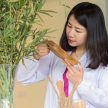在工地,我们可以看到它被用来充作建筑材料,它也是熊猫的食材。如今Ford计划将这个在大自然多处可见,且坚韧的竹子应用在造车材料(内饰)上,更进一步展现Ford环保的制造工艺。
根据厂方表示,经一系列的材料试验结果,竹子比合成和天然纤维更优。这包括抗冲强度试验、冲击强度试验、以及高温试验等。在进行高温试验时,原厂将材料加热至212华氏度,以确保它可以在高温下保持完整性。
耗费巨资的科学研究带来了如碳纤维和轻量铝合金等新材料的技术突破,然而大自然中随处可见的竹子也不遑多让,竹子以其坚韧的延展性为名,且相对需要数十年才能生长的树木,竹子光是一天就能生长高达1公尺,且在短短的二到五年内就可完全长成,是极为容易再生的材料。
- Over the past several years, Ford worked with suppliers to evaluate the viability of using bamboo in vehicle interiors and to make extra strong parts by combining it with plastic. The team has found that bamboo performs comprehensively better than other tested synthetic and natural fibers in a range of materials tests, from tensile strength tests to impact strength tests.
- Janet Yin, a materials engineering supervisor at Ford’s Nanjing Research & Engineering Centre, and her team have researched the use of bamboo for vehicle parts because of its tensile strength – or how much it can resist being pulled apart – which can rival or even better some types of metal.
Ford南京工程研究中心的材料工程主管Janet Yin说,中国和亚洲许多区域都盛产竹子,它是一种强韧却又富有弹性的永续再生材料。在过去几年,Ford一直与供应商合作,评估将竹子用于汽车内装的可行性,并将竹子与塑料结合制成格外强韧的零组件。
目前,Ford所生产的车辆在全球有近300个零件都是以植物为原料萃取制造的,包括棉花,大豆,木材,亚麻,黄麻纤维和天然橡胶等等。例如Escape车型的门板。此外,消费后的EcoLon尼龙地毯也被用在Escape、Fusion、Mustang,以及F-150车型的引擎缸盖上。


